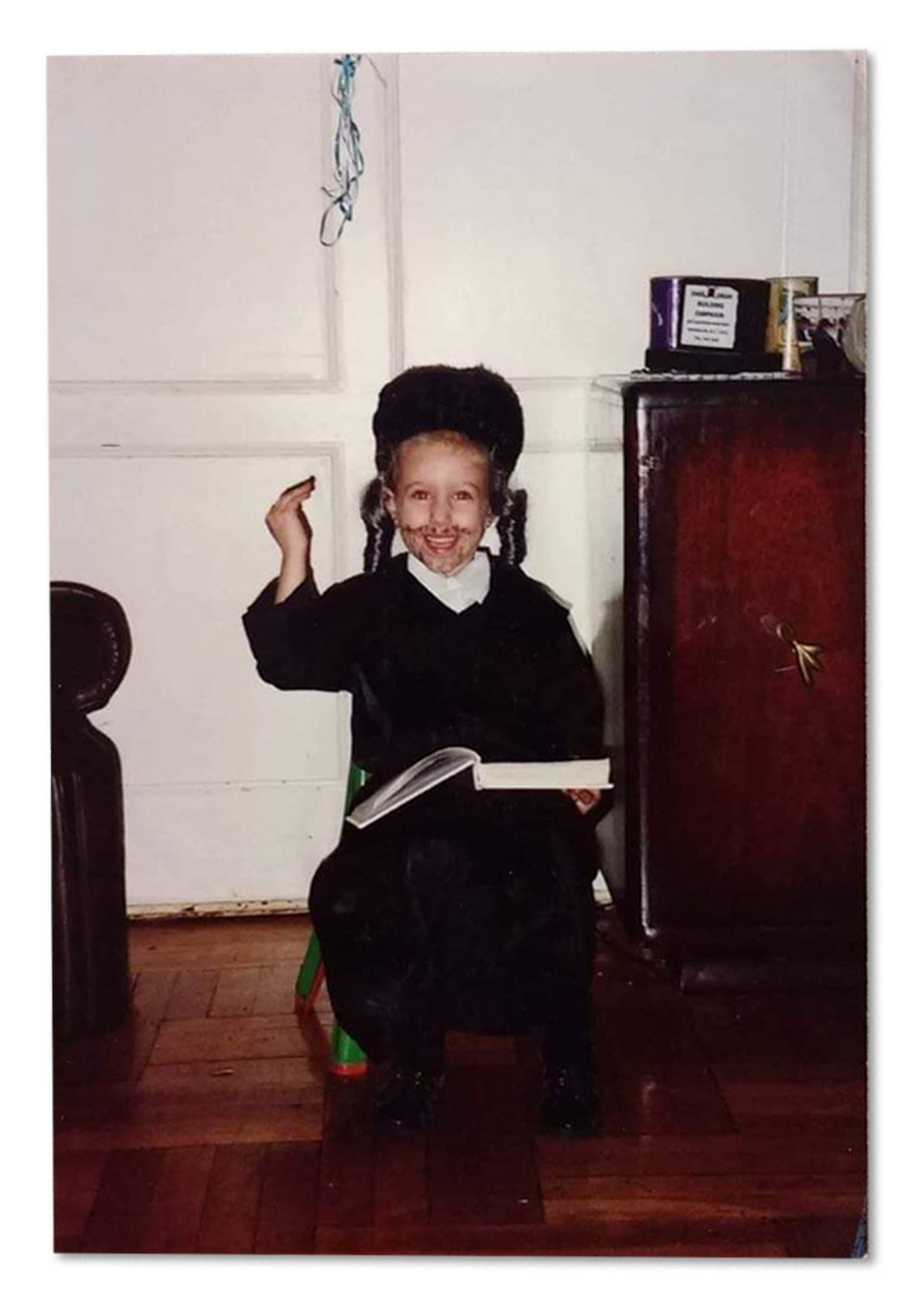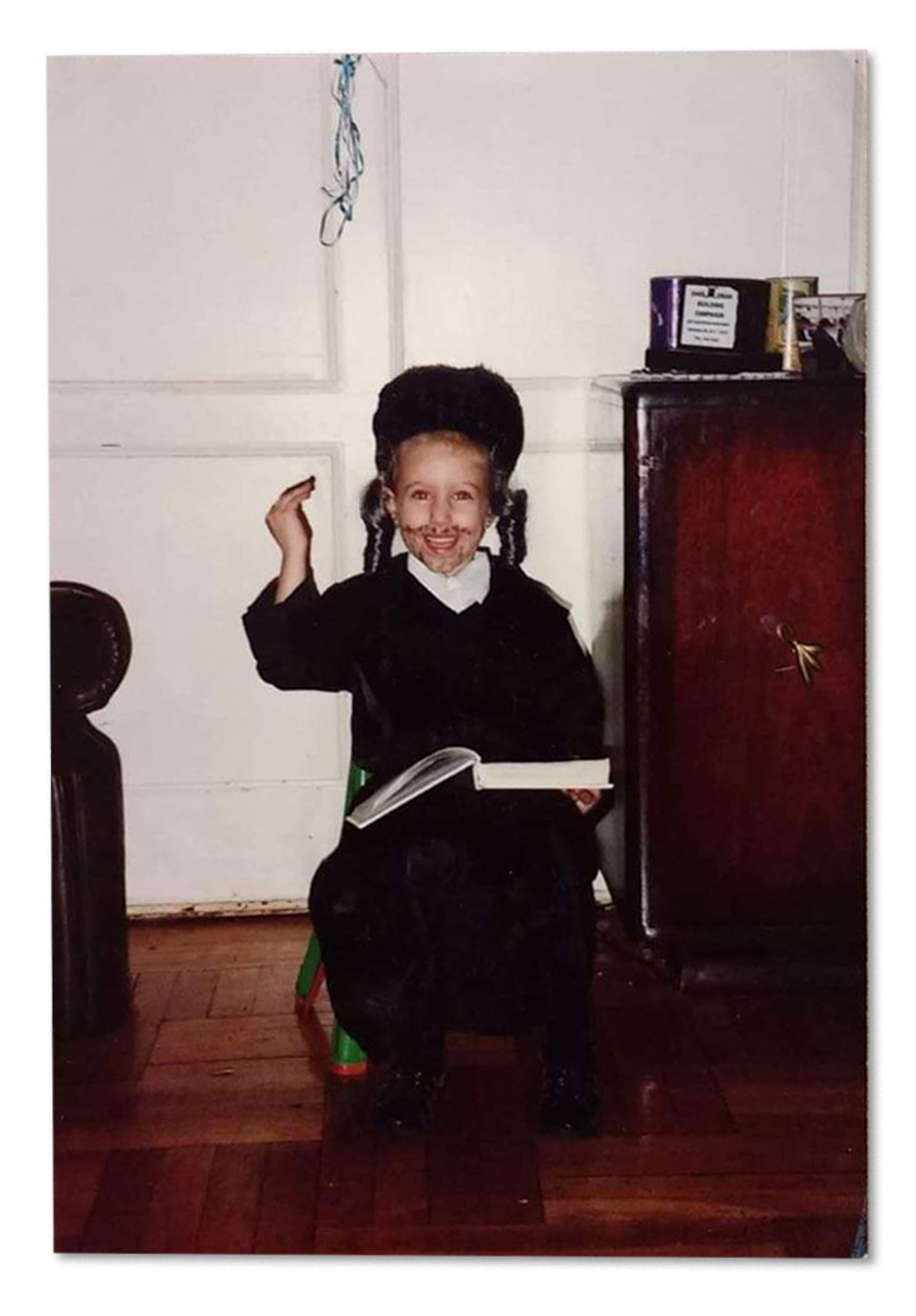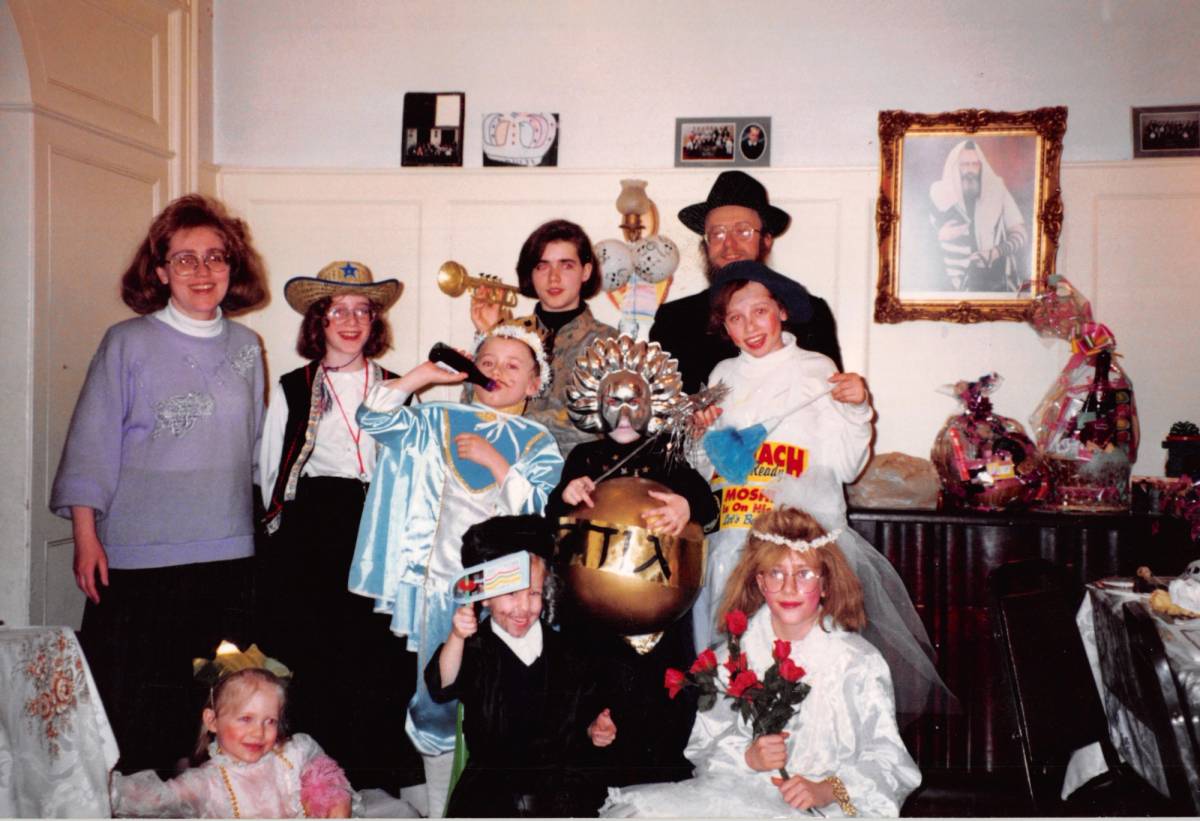The Little Girl in the Big Black Hat
Growing up Hasidic, my unconventional choices for Purim costumes allowed me to take on other identities

Courtesy the author

Courtesy the author

Courtesy the author

Courtesy the author
When I was 4 years old, I asked my mom if I could dress up as a Yoeli for Purim.
I grew up in a Hasidic sect called Chabad, where our men cut their side curls and wear a pinched top hat. A Yoeli is what my sect calls a Hasidic man in the rival Satmar sect who wears side curls and a fur hat. (Many Satmar Hasidim name their sons Yoeli in memory of their deceased leader, Rabbi Yoeli—so much so that Yoeli became a satiric nickname for the group.) In both these Hasidic sects, the men sport untrimmed beards and long silk frocks tied with a twisted fabric rope around the waist.
Purim is all about being topsy-turvy, dressing up in unlikely costumes. What could be more upside down, I thought, than a Chabadnik with a fur hat? The irony that I was dressing up as a member of the Hasidic sect most like mine never occurred to me. When you’re on the inside, the smallest differences feel like worlds apart. Perhaps we all mock those who are most like us.
At first, my mom said no. The Yoeli costume was specifically designed for little Satmar boys who wanted to imitate their dads. That was no outfit for a girl.
Then we went to the costume store in Boro Park, Brooklyn. I marched past the aisles filled with colorful dresses, jewelry, tiaras, and petticoats.
Free spirit adorned me in the way other girls wear shiny jewelry. I wanted to wear a provocative costume, one that would cause folks to tsk and good-naturedly call me “the feisty one.”
Up on a high rack behind the counter, I spotted the most exquisite set of clip-on side curls, beautiful in their unique bizarreness. I asked the man behind the counter if I could please try them. Thick, round, brown, ringlets were clipped to the sides of my head with metal snap-on barrettes that heavily framed my petite face and big green eyes.
My mom rolled with laughter seeing me in those “lange payes.” She couldn’t help but be my partner in crime on this risqué costume. Underneath her extreme religiosity cried a feminist who wished to be free. My mother found a little loophole: If she couldn’t have the freedom only allowed to men in our community, perhaps she could gift it to her daughter for just one day. Dressing up as a Yoeli was just the right mix of funny and creative for topsy-turvy day. A way to stick it to the man while preserving our familial dignity and keeping the gossipers whispering in the sidelines.
Mom bought those side curls on the spot. She also found a soft fur black shtreimel that fit perfectly, sitting nice and tall on my little head, crowning my blond locks.
We could not find the signature long black silk frock in my size, but my fiercely loyal mom came to the rescue. If I was going to turn heads being a Yoeli, then my mom was going to dress her creative, clever daughter in the most dashing of costumes. She bought some satin fabric and sewed me a beautiful little coat and found a twisted cord belt to wrap the coat around me.
I’m not sure where Mom found the black silky pantaloons I wore. Maybe she altered one of my sister’s old costumes: Our girls-only school did an annual production, and if one of the girls had to dress up as a rabbi, they sewed fluffy pantaloons that ended in pants past the knee line so no one would see the shape of a girl’s thigh, which was considered immodest.
That Purim is forever painted in my memory. It’s the strongest early childhood recollection I have.
Through the prism of my 4-year-old eyes, I remember relishing every moment of putting on my costume, running my fingers down the satiny frock, circling them over the plush buttons. I stroked the fuzzy curls nestling my face. I carefully caressed the fur hat on my head, glossy fibers whisking across my fingers. Is this what it feels like to be a grown-up? A man? A Yoeli?
Before we headed to the synagogue to read the Purim story, my sister quickly painted a little beard and moustache on my face.
“Get the camera!” Mom said.
My face shone with excitement, my smile ear to ear, and my eyes gleaming. I sat on a chair with a big book on my lap. I put my hand up in the air gesturing as if I were a rabbi saying a sermon. My sister snapped the picture.
The next day, my tween brother and I went tramping around Crown Heights handing out mishloach manot snack packages to our friends. He was dressed as a bride—a kallah—with a puffy white dress, big costume gold necklaces, and my mom’s old blond wig with a sheer veil attached to the back. On his feet were my big sister’s black pumps.
Folks pointed and laughed as they inquired about “the boy” dressed as a Yoeli.
“No, I’m a girl,” I replied with a laugh. I relished the attention my creative costume attracted but I was puzzled as to why no one on the street said anything to my brother.
The people on the street do not realize that my brother is a boy, I thought to myself. That’s why they didn’t comment on his costume. A bride outfit was standard Purim dress-up, albeit unusual for a boy. However, a child wearing long clip-on side curls to caricature our rival sect garnered lots of attention.

Courtesy the author
In a community that prides itself so much on appearances, children are expected to want to imitate their father, not a rival sect. That a boy would choose such a costume was surprising; for a girl it was simply unfathomable.
When we got to my friend’s house, her mom was confused: “A girl dressed as a Yoeli and a boy as a kallah? I’ve never seen this one before,” she chortled.
Then our family went to my grandmother’s house for the holiday meal. My cousins laughed raucously.
“We didn’t even recognize you. We just assumed someone dressed like a Yoeli was a boy,” they joked.
“No, I’m the Yoeli,” I giggled.
I felt a bit uncomfortable. My cousins’ laughter made me wonder if my costume was weird rather than unique. I saw my aunts whispering in the corner. I suddenly had a sinking feeling they were making fun of my beautiful, funny, radiant mother.
In Crown Heights on Purim most anything goes, but maybe a girl dressed as a Yoeli and a boy as a bride pushed the envelope just a little too far for some.
My parents are incredibly religious—at the extreme end of Hasidic even by our community standards. I suppose my dad may have vetoed my costume if he was asked, but taking care of kids’ costumes simply wasn’t part of his role as provider. Fortunately, I had my mom on my side.
No one laughed at me when I attended the party at my day care dressed in my Yoeli attire. But the rest of my class dressed as the female heroine of the Purim story, Queen Esther, in colorful, puffy princess dresses.
I vaguely remember wondering why all the girls but me wore the same costume.
The next year I didn’t want to give up my Yoeli costume, but it’s an unwritten Purim tradition to choose a new costume every year. I decided to compromise by dressing up as Mordechai, the hero and Queen Esther’s co-star in the Purim story.
I kept my Yoeli costume, with the side curls and fur hat. My mom simply added a Mordechai mask and a fake beard. But did Jews in fifth century BCE, when the Purim story took place, wear side curls and fur top hats? If Mordechai was in fact a Hasid, then I nailed that costume.
I arrived at my preschool’s Purim party with high hopes that my new costume would pair well with the multitudes of Queen Esthers. Mordechai was Queen Esther’s uncle, after all.
But someone must have sent a memo to every girl in my class that it was time to switch from princess to kallah.
A brood of brides swished through my classroom, heels clicking, gowns swirling and swinging. White satin filled the kindergarten at my all-girls school on topsy-turvy day. Amid the clouds of white, I sat dressed as Mordechai, in all black, with a tall black fur hat, silk black coat, black pantaloon pants, and a wide bushy black beard.
I loved stroking the beard. It made me feel smart, like a grand rabbi. But I was embarrassed in front of the other girls. I didn’t understand. There were so many costumes to choose from—why did they all have the same one? What was the secret they shared that I didn’t know about?
I waded through the petticoats searching for one girl dressed as anything other than a bride. There were none.
The miracle of Purim breathed life into my character.
I thought Mordechai was a safe bet to fit in with my peers. He was a Purim story character after all. Surely there would be other girls representing the cast of characters. Why were they all brides this year?
Looking back, I wonder if Purim dress-up was my first insight into social contagion or fad culture. I perceived unusual as cool and beautiful. Did my peers prefer sameness?
Now my big bushy beard just felt silly. I sat on the side refusing to join the class picture. The teacher came over and took a photo of me alone.
The next year, I ditched the side curls and fur hat but the embarrassment I’d felt at school did little to wound my pride over my liberal costume choices. Fitting in was not in my vocabulary. Imagination was the territory I roamed.
My creative costume choices finally came to a roaring halt the year I decided to dress up as Haman. Even my mom, my forever champion, had her limits.
“No child of mine is going to be Haman,” she said, putting her foot down.
“But it’s a costume,” I replied, with equal weight.
“No, not even for a costume.”
“But that’s the whole point of Purim. Dressing up as the key villain of the story that wanted to murder all the Jews epitomizes topsy-turvy day.”
Mom did not budge. Even topsy-turvy day had its limits.
I negotiated. I pleaded. I cried. None of my usual tactics worked.
“Pick another costume,” she urged.
I shook my head no, stubbornly determined.
Purim eve arrived and I sat in the living room, my head hung low. Around me, my siblings were busy with costume jewelry and gold foiled sticks of face makeup. Mom gently took my hand: “Come, let’s go to the store.”
The costume store was almost empty. Mom searched through the square bags left on the rack. She opened one of the bags and lifted a beautiful long sky-blue robe inlaid with colorful stones.
“The Kohen Godol costume is perfect for you, sweetie. He’s the high priest; the most important man of the entire Jewish people.”
My eyes welled with tears.
I reluctantly allowed Mom to put the flowy robe in my arms. The costume came in a thick square plastic bag. It was nothing like the custom-made costumes Mom had helped me create before.
That evening I attended Purim services at the synagogue attired in my new costume. The blue gown felt scratchy, the colorful stones looked like big fake plastic squares. The service I normally loved seemed to last forever.
After services, I stripped off the hideous blue gown with the colorful stones. I did not dress up for the school party or for Purim lunch at Grandma’s.
When I think back at it though, no one made fun of me when I wore the Kohen Godol costume. So why did I loathe it so much?
Maybe the idea of a store-bought costume made me feel like a girl with a princess dress—too conventional, like I fit in too well.
I realized that dressing up to suit my mom’s idea of what I should be hurt my imagination too much. I learned that fitting in gnawed at me even worse than standing out.
I have replayed the day I dressed as a Yoeli a million times in my mind. A Groundhog Day that will last a lifetime. The day I reveled in being the person I was least expected to be.
Purim was a portal. I was able to walk out of the book of my imagination and bring my character to life. It was the day I reshaped my identity. A time to imagine what it would look like to belong to another tribe, to be a grand rabbi, a villain, or a king.
The Yoeli was the pinnacle for me. A little girl dressed up as a man. A Chabad Hasid wearing the garb of a rival sect. That was the person I saw myself least likely to become.
The miracle of Purim breathed life into my character. My inner Yoeli exists now and forever, because I was one for a single, topsy-turvy day.
Mina Marsow, grew up in Crown Heights, Brooklyn, as one of nine children in a devout Hasidic family. She founded Prospect Gymnastics, and has built a career advocating for child wellness and community development.